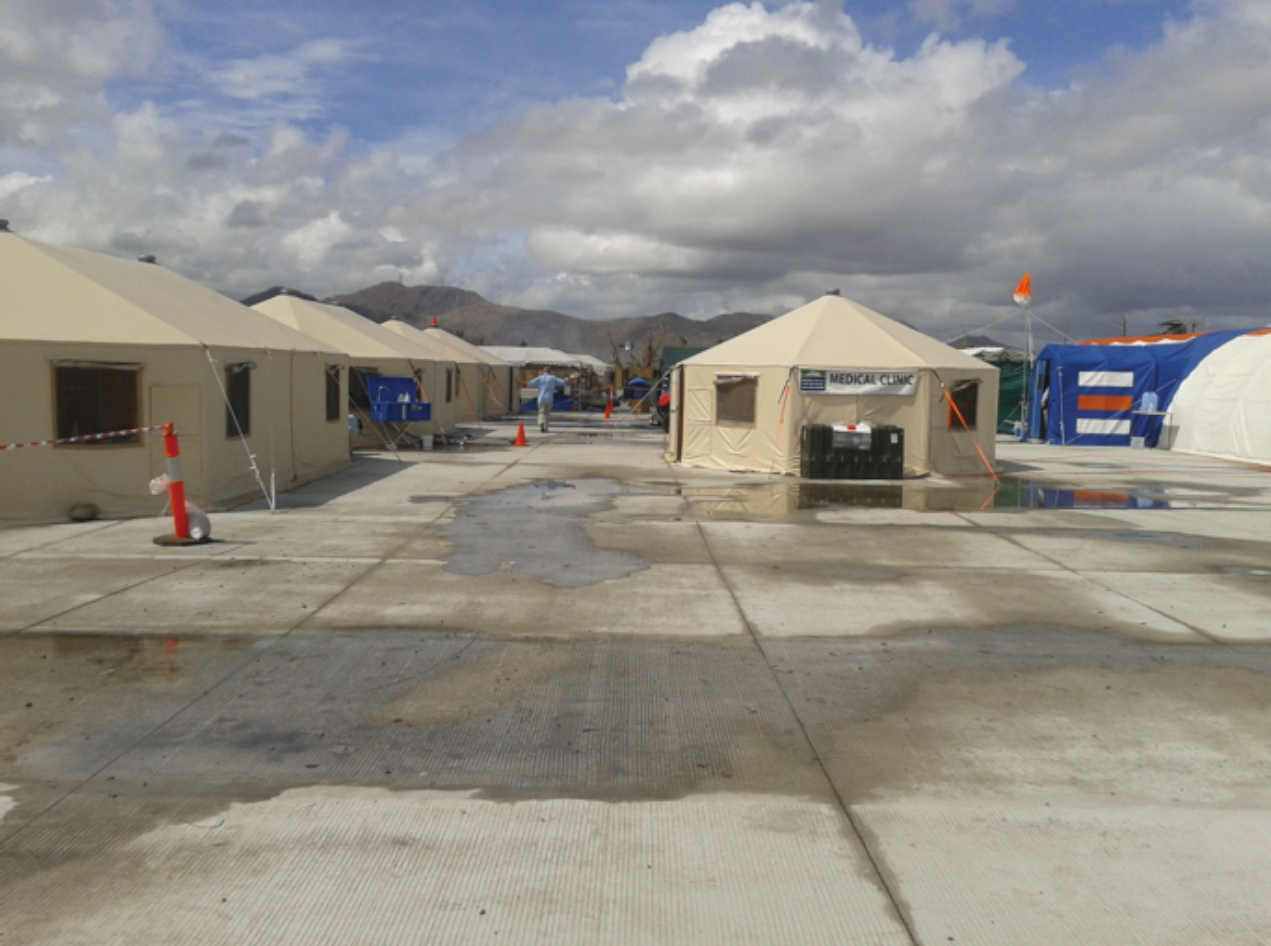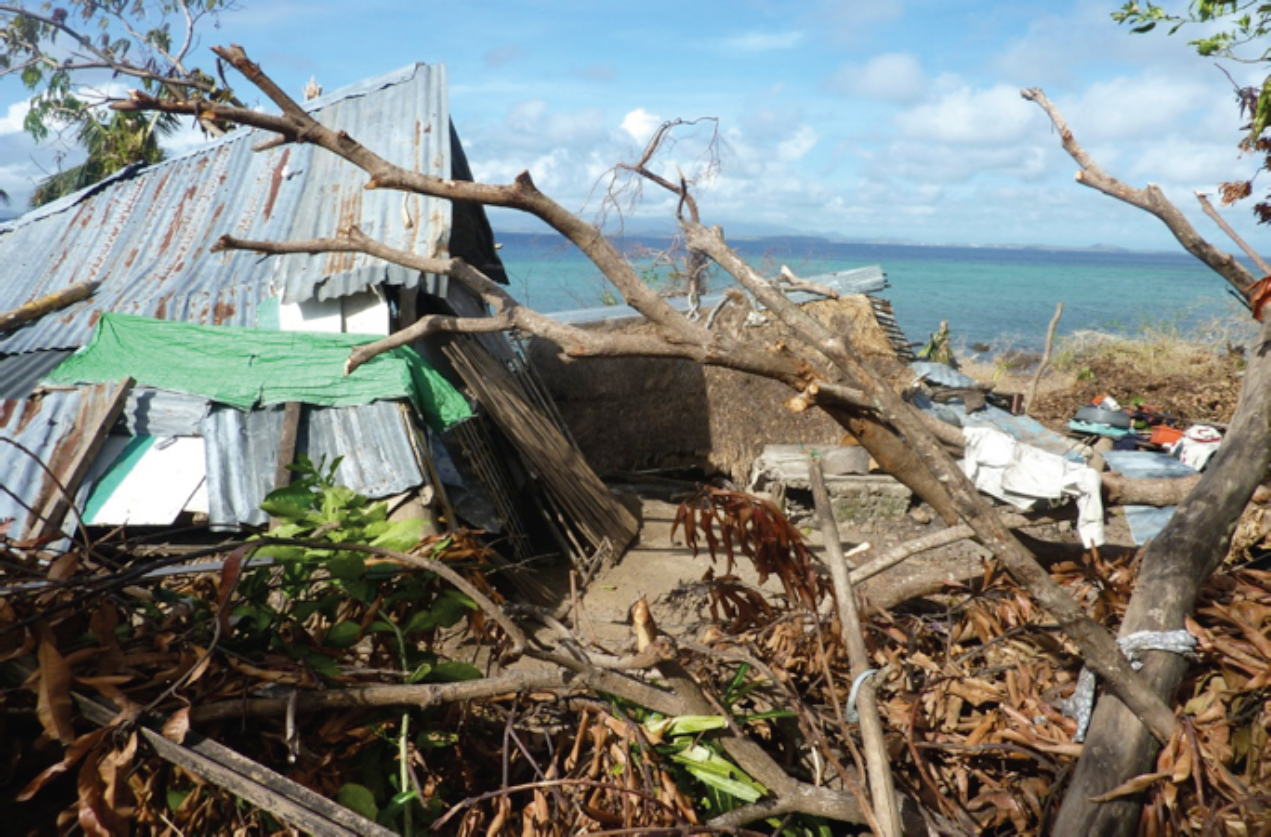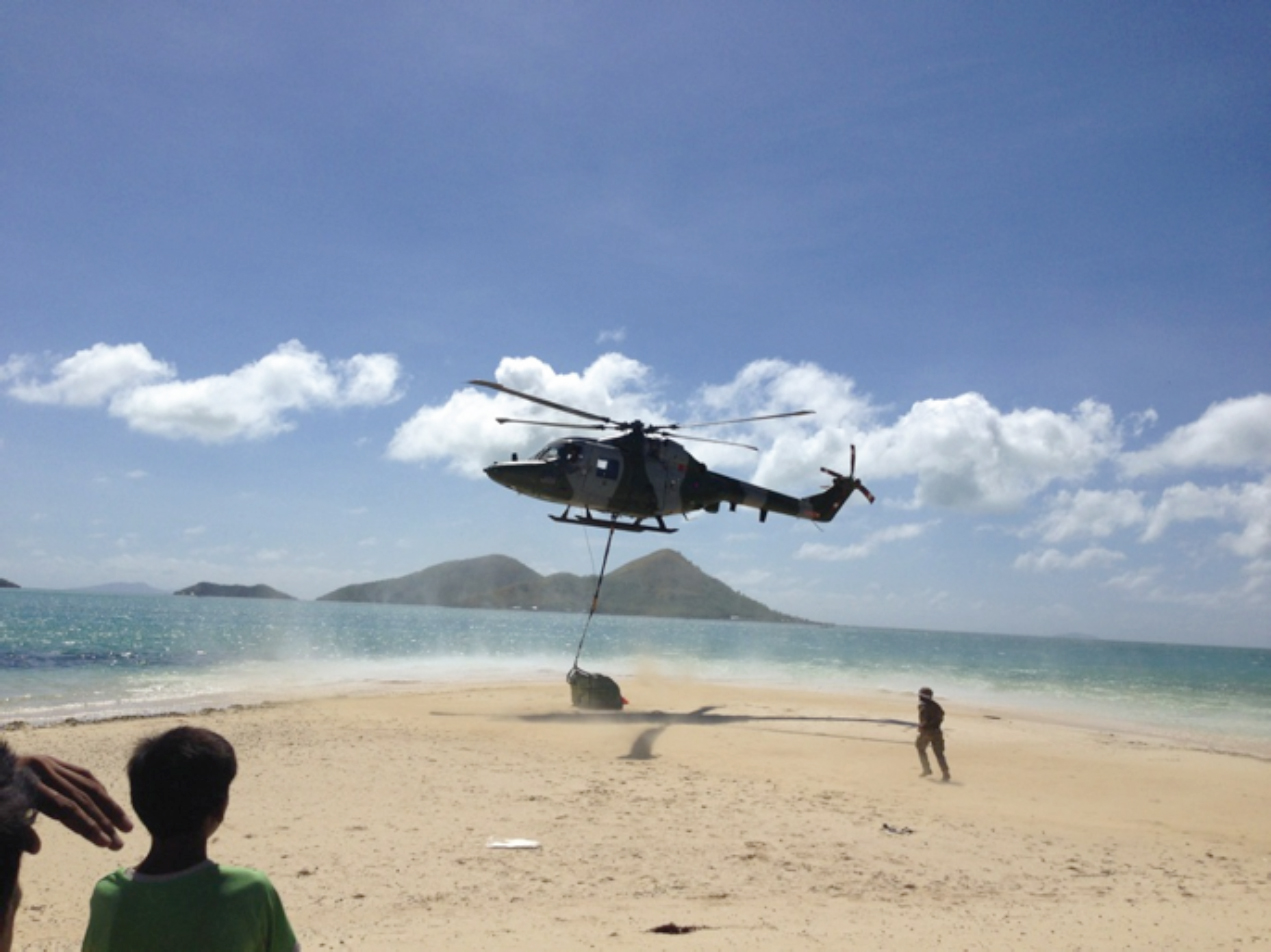On 8 November 2013 Typhoon Haiyan hit the Philippines. The Philippines endures many typhoons and has early warning systems and evacuation plans that saved many lives. Local aid including medical teams were mobilised but Super Typhoon Haiyan and the storm surge that accompanied it overwhelmed the countries capacity. More than 14 million people were affected, over 6 000 deaths, nearly 2 000 missing and 4.1 million people displaced. Over a million homes were destroyed, together with livelihoods and infrastructure (Office for the Coordination of Humanitarian Affairs Philippines, 2014). To support the health needs following the Typhoon, the Philippine government invited international medical assistance.
Tim Byrom deployed to Tacloban
It is heartening to see the world rally together to assist in devastating events such as this. Many countries immediately mobilised resources in various capacities. The United Kingdom, small island though we are, was generous in its response. As well as the huge involvement from many non-governmental organisations (NGOs), the UK government by way of the Department for International Development (DfID) provided great assistance through an integrated and collaborative humanitarian aid package. The British Military provided essential logistical platforms through HMS Daring and HMS Illustrious, as well as multiple military cargo planes, provision of food, personnel, shelter, sanitation and building materials.
I was mobilised as part of the first 13-strong UK International Emergency Trauma Register (UKIETR) team following a request from the Philippine government for international medical assistance. This team included three surgeons, two anaesthetists, two emergency clinicians, one general practitioner, one operating theatre nurse, two emergency nurses and one physio, all of whom had completed relevant pre-deployment training.
Following arrival in Cebu and after registration of the team with the Ministry of Health/health cluster, the team was split in order to target a range of health needs, identified by the Ministry of Health. Half the team deployed onto HMS Daring to assist in health assessments, distribution of aid and primary health care among the islands off the Northern tip of Cebu. Many of the islands had yet to be reached or receive aid due to the logistical challenge of access, and little was thus known about the health status of the community following the typhoon. Access to the islands was achieved through use of the logistical and crew assets provided by HMS Daring, resulting in a very effective response.
Our team was attached to the Australian Medical Assistance Team (AUSMAT), who had established a tented field hospital in Tacloban—reportedly the worst affected area in the Philippines. The field hospital was established on a hard standing on the edge of Tacloban airport, within a mile of Toclaban city and accessible to patients.
Tacloban is a reasonably developed city. It was not simply the winds that caused damage, but the destructive effects of the tidal surge also caused a great amount of devastation. The city had a number of small health facilities and one large 200-bedded central hospital. The hospital was not totally destroyed but its capacity was severely reduced. The entire ground floor had suffered the storm surge and was engulfed in mud, which together with no power, damage to the roof, destruction of equipment/medical supplies, reduced staffing levels and a high number of casualties resulted in the hospital being overburdened.
Our teams' focus was to strengthen the AUSMAT operational surgical capacity by means of two orthopaedic surgeons, two anaesthetists and a theatre nurse. We also provided a physiotherapist, whose skills were soon realised to be invaluable. I became the logistical lead for our team, but was also heavily involved in working within triage and the emergency room.
The AUSMAT field hospital, comprising 30 tonnes of equipment, was staffed by a 36-strong team of clinicians and logisticians, all of whom had undergone appropriate pre-deployment training. The team was further strengthened by local Philippino staff. The setup was remarkable and operated as units supporting triage, resus (including a mobile X-ray), majors, minors, three wards (totalling 40 beds), one theatre (with 2 operating tables), pharmacy, stores tents, admin tent and accommodation. The UK team, in a similar manner to the AUSMAT team, deployed with individual kit bags containing among other items: personal tents, water systems, mosquito nets and water purification tablets, thus ensuring personal self-sufficiency once in-country.

The workload was high. There were on average 15–20 operations per day. These were varied and included many wound debridements, management of limb injuries and revision of surgery following infections. Throughout the facility we attended to over 150 patients per day, with the busiest day seeing approximately 250 patients. As expected, there were a high number of injuries. The mechanism of injury was often as a result of flying debris and falling trees, with resulting trauma ranging from lacerations and haematomas to fractures and crush injuries. Housing was of solid brick construction in the centre of Tacloban; however, there were many houses on the edge of the city of less sturdy construction, most with corrugated metal roofs. These proved lethal, offering no defence against the Typhoon and resulting in many severe lacerations and fatalities from the metal.
The AUSMAT and UK team partnered closely with local Philippino clinicians in identifying and managing patients requiring treatment, and ensured integration with local healthcare systems. Medical professionals worked tirelessly to prevent infection, although inevitably, due to the less sanitary conditions resulting from the Typhoon, some wounds did become infected and required revisiting and further attention. Consideration was also given to the inherent problems associated with the vast amounts of standing, stagnant water left by the Typhoon—such as possible vector habitats for malaria and dengue outbreaks.
As the deployment progressed, the surgical workload lessened and there was a shift to more primary health and chronic health needs. Examples of cases seen included upper respiratory tract infections, diarrhoea and the ongoing chronic and obstetric health needs. It is important to remember during a disaster that pre-existing health needs will continue in addition to any trauma needs, and thus foreign medical teams (FMTs) should have the operational capability to identify and assist in managing these needs in collaboration with local health systems.
There were numerous poignant accounts of personal suffering as a result of the typhoon. One lady presented 12 days post-typhoon with a very deep untreated laceration to her scalp. The tree that had inflicted the damage had killed her husband. She had been unable to access health care due to tending to her children and sheltering in a refuge centre.
I consider myself well-travelled and have experienced numerous places burdened by war and poverty. I was, however, not quite prepared for the extensive devastation that I witnessed throughout the city. Although images from television provide some insight, only when on the ground can you truly appreciate the enormity of the destruction.
I am thankful to have been part of the UK team and in a position to have contributed in a small way to the aid effort. My thanks extend to North West Ambulance Service NHS Trust who supported my deployment without hesitation, and to colleagues who provided cover during my absence. I have the utmost respect for the work of the aid teams who contributed to the effort, but in particular to the outstanding work by the Australian Medical Assistance team.
Peta Watts deployed to HMS Illustrious
I had negotiated leave with work, and reported my availability as soon as UK-Med had sent out the call for a second team to deploy to assist with health needs following Typhoon Haiyan, or Super-Typhoon Yolanda, as it was known locally. The team was confirmed on 06:00 hours on 22 November and left from Manchester airport 24 hours later. We took some medical supplies with us and received the rest from the first team when we met them in the Philippines.
The second UK-Med team consisted of six members from the NHS: two emergency care doctors, one GP/pre-hospital care doctor, two emergency care nurses, and myself, a paramedic. All had experience of international work and all had been through the UKIETR pre-deployment course.
Our task was to continue assessments on some of the islands that had yet to be accessed and be ready to deliver health care where appropriate. The health needs were likely to be focused around primary care rather than acute needs as two weeks had passed since the Typhoon. One important role was to gather indicators on infectious diseases and general health needs of the communities, which could then be fed back into the health cluster and the World Health Organization (WHO).
We flew to Cebu, a logistical hub for the international relief effort. Here we met the outgoing UK-Med team and received a handover and briefing for our task. On the military airfield where we were to liaise with a C132 to take us onto Roxas, were a fleet of international aircraft, busy ferrying teams and supplies. At Roxas we were taken out to HMS Illustrious by helicopter, the first of many subsequent helicopter flights to and from the ship.
Operation Patwin demonstrated an effective and unique joint civilian and military response to a disaster, using a military vessel as the operational platform. The Philippines is an archipelago of over 700 islands, and access to many of the islands is logistically challenging. HMS Illustrious had been loaded in Singapore with 500 tonnes of aid prior to routing to the Philippines. The response was a joint services operation with Army and RAF personnel strengthening the ships crew. Logistical assets included seven helicopters (one Merlin, three Sea kings, three Lynx) and a number of fast response boats. A DfID humanitarian advisor, a military/civilian liaison advisor and logistician also formed part of the team. The collaboration also included a number of Philippino Navy officers, their presence and role crucial to assisting the teams understanding of local community infrastructure on the islands, and in their role as translators. In addition to the ships resident medical team and ourselves, a military Role 2 surgical team had been mobilised from the UK. They were to provide medical assistance to any military personnel injured during response activities on the islands, and were not part of the medical team deployed to the islands.
The UK-Med team joined HMS Illustrious on 25 November just off the north east coast of Panay Island in the central Philippines. That first evening we were busy in the ship's clinic with our supplies. Unsure as to how we would deploy in the coming days we wanted the flexibility of working in teams of two, three or six, depending on logistics and need. Three identical clinic bags and documentation were prepared from our kit. Lack of patient documentation and aftercare has been criticised in previous disaster responses (Redmond et al, 2011). Although no current standardised medical record-keeping document exists for foreign medical teams (FMTs), a simple patient report form, referral letters and register for patients and treatments delivered was developed. This information was then fed back to the health cluster and WHO, which helped map on-going health needs throughout the Philippines.
There was a lot to learn, quickly: essential safety requirements for life on board and around the helicopters, when and where to get fed and how to find one's cabin! We were warmly welcomed and soon the ship became a familiar environment. Days were long; we breakfasted at 04:00 and then gathered in the ships hold to wait for our transport to the islands. Humidity was >95% and hydration a challenge all day. Mixed civilian-military teams were deployed to various islands with a humanitarian advisor and Philippine Navy officer. On arrival on each island, contact was immediately made with the village captain, and the local response directed under her guidance. Health information gathered included pre- and post-typhoon conditions, trauma injuries following the typhoon, any disease outbreak (such as respiratory), the health status of children under five years of age, health status of the elders and the number of births. We designed an assessment tool suitable to meet the required data collection needs after discussions with local communities. Very few deaths were reported on these islands but there were a small number of injuries, and some infected wounds. There were some psychosocial needs reported such as difficulty in sleeping. Villagers described a lot of destruction, particularly to fishing boats—an essential means for access to mainland and community economy through fishing. Islands differed, some had suffered storm surges, others not. Destruction of trees resulted in a lack of shade, and missing roofs affected islands that used this as a method of rainwater catchment. Some islands' water supply was affected if wells were contaminated with debris or seawater.
Primary healthcare clinics were run in collaboration with the islanders. Many of the community were able to assist with translation and facilitation of the clinics. The team focused on treating conditions caused or exacerbated by the typhoon and secondary to disruption of the islands' healthcare system. It was important not to undermine normal healthcare structures or foster unrealistic expectations nor deliver health care unsuitable for the local resources. Integration with local clinicians and within existing health structures was vital. Ensuring appropriate continuation of care of any patients treated is also crucial. In my role as a paramedic, I was involved in conducting some of the assessments, in organising the structure of the clinics, registering patients, triage, liaising with local health workers and the village captain and organising patient flow. Proper consideration had to be given to exit strategies, which meant communicating with both the ship and islanders to ensure clinics wound down naturally. As the clinics ran, they provided us with a more comprehensive, qualitative picture of life before the typhoon, the effect it had had on communities and how they were rebuilding. Communities on the islands showed incredible solidarity, resilience and strength. Islanders were very clear about their priorities, which was to regain their livelihoods. Many of the damaged fishing boats were repaired by crews from HMS Illustrious, thus enabling communities to return to fishing and able to access other islands.


‘The UKIETR is a DflD-funded and UK-Med hosted register onto which health workers interested in deploying as part of a trained team to a sudden-onset disaster can apply’
It was clear that clinics should not be held if there was no need, especially if other agencies had already engaged in this. Analysis of past disasters often criticised inappropriate or duplicate responses (Bennet et al, 2006). Communicating with the health cluster was crucial. Evenings were spent writing up sit-reps and collating health data. Although the health care provided was limited, the information fed back to the health cluster regarding chronic conditions and general health status of the island was valuable in the on going humanitarian response and targeting of health needs.
Our team became a cohesive, supportive unit, working with the local community and identifying pre- and post-typhoon health gaps and confidently collaborating with DfID and the military. There are a number of lessons identified from the UK response, and improvements to be made for future responses, but it demonstrated effective interagency working and it has been a valuable learning experience for all those involved. Like Tim, I am indebted to NWAS and my colleagues who supported my deployment.
The UK International Emergency Trauma Register (UKIETR)
UKIETR evolved following the experiences of a group of clinicians involved in medical care in previous disasters. A number of concerns regarding medical care in disasters have been highlighted in the past, particularly following the Haiti earthquake in 2010. Problems associated with lack of training and preparation of medical teams deploying, lack of self-sufficiency of teams arriving in country and thus drawing on the already strained resources of the affected countries, and a lack of understanding of the context in which medical care was being provided were evident. There was often little coordination, no registration of teams, poor understanding of the humanitarian infrastructure and response, limited reporting and medical record keeping and poor engagement with government health departments regarding appropriately targeting and supporting the countries' health needs. Many medical teams left after a number or days or weeks without structured and integrated exit strategies. In addition, health standards suffered from a lack of accountability and quality control, leaving disaster-affected communities vulnerable (Foreign Medical Team Working Group (FMTWG), 2013).
The UKIETR is a DfID-funded and UK-Med hosted register onto which health workers interested in deploying as part of a trained team to a sudden-onset disaster can apply. The UKIETR works in collaboration with Save The Children and Handicap International to ensure effective logistical support in country for the deployed field hospital, appropriate integration with local health systems, continuation of patient care and appropriate rehabilitation of all patients treated. UK-Med ensures appropriate training, education and preparation of clinicians on the register prior to deployment, delivering focused pre-deployment team training on both context relevant skills (such as security, humanitarian infrastructure, logistics, operational) and clinical skills (such as surgery and anaesthesia in austere environments). All teams complete relevant security courses and undergo health travel checks and vaccinations as part of their preparation. There is a full range of NHS specialities on the register and thus an extensive pool from which to draw from. Deployed teams aim to be between 12 and 24 strong and composed of emergency medicine clinicians, surgeons (including obstetricians), anaesthetists, operating theatre nurses, paramedics and rehabilitation physiotherapists. There is a commitment to ensuring adherence to the required minimum standards and core principles for foreign medical teams (FMTWG, 2013).

